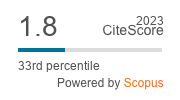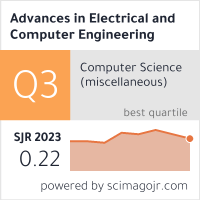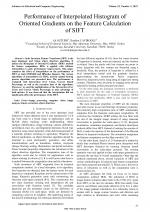| 3/2022 - 10 | View TOC | « Previous Article | Next Article » |
Performance of Interpolated Histogram of Oriented Gradients on the Feature Calculation of SIFTOZTURK, A. |
| View the paper record and citations in |
| Click to see author's profile in |
| Download PDF |
Author keywords
image processing, computer vision, image analysis, feature extraction, object detection
References keywords
vision(9), image(9), scale(8), recognition(7), pattern(7), invariant(6), processing(5), local(5), feature(5), space(4)
Blue keywords are present in both the references section and the paper title.
About this article
Date of Publication: 2022-08-31
Volume 22, Issue 3, Year 2022, On page(s): 87 - 94
ISSN: 1582-7445, e-ISSN: 1844-7600
Digital Object Identifier: 10.4316/AECE.2022.03010
Web of Science Accession Number: 000861021000010
SCOPUS ID: 85137667974
Abstract
Scale Invariant Feature Transform (SIFT) is the most dominant and robust object detection algorithm. It utilizes the Histogram of Oriented Gradients (HOG) method for feature computation. HOG is applied with trilinear interpolation to gain performance improvement. This paper examines the effect of interpolation on the performance of SIFT on both OXFORD and HPatches datasets. The various algorithms of interpolation for HOG, and the spatial binning process algorithm, are presented here. The performance is evaluated with Intersection Over Union, Correct Match Percentage, as well as the execution time of the algorithms. Moreover, we used the multiplication of the Intersection Over Union and Correct Match Percentage to take advantage of both metrics. It was observed that the interpolation did not significantly affect the performance of the SIFT. |
| References | | | Cited By «-- Click to see who has cited this paper |
| [1] D. G. Lowe, "Object recognition from local scale-invariant features," in Proceedings of the Seventh IEEE International Conference on Computer Vision, Sep. 1999, vol. 2, pp. 1150-1157 vol. 2. [CrossRef] [2] D. G. Lowe, "Distinctive image features from scale-invariant keypoints," International Journal of Computer Vision, vol. 60, no. 2, pp. 91-110, Nov. 2004. [CrossRef] [Web of Science Times Cited 34701] [SCOPUS Times Cited 48146] [3] T. Tuytelaars, K. Mikolajczyk, Local invariant feature detectors: a survey. Now Publishers Inc, 2008, [CrossRef] [Web of Science Times Cited 919] [SCOPUS Times Cited 1228] [4] J. Babaud, A. P. Witkin, M. Baudin, R. O. Duda, "Uniqueness of the Gaussian kernel for scale-space filtering," IEEE transactions on pattern analysis and machine intelligence, no. 1, pp. 26-33, 1986. [CrossRef] [Web of Science Times Cited 460] [SCOPUS Times Cited 627] [5] T. Lindeberg, "On the Axiomatic Foundations of Linear Scale-space," in Gaussian Scale-Space Theory, J. Sporring, M. Nielsen, L. Florack, and P. Johansen, Eds. Dordrecht: Springer Netherlands, 1997, pp. 75-97. [CrossRef] [6] P. Getreuer, "Linear methods for image interpolation," Image Processing On Line, vol. 1, pp. 238-259, Sep. 2011. [CrossRef] [7] I. R. Otero, M. Delbracio, "Computing an exact gaussian scale-space," Image Processing On Line, vol. 6, pp. 8-26, Feb. 2016. [CrossRef] [Web of Science Times Cited 8] [8] K. Mikolajczyk, C. Schmid, "Scale & Affine invariant interest point detectors," International Journal of Computer Vision, vol. 60, no. 1, pp. 63-86, Oct. 2004. [CrossRef] [Web of Science Times Cited 2420] [SCOPUS Times Cited 3388] [9] I. R. Otero, M. Delbracio, "Anatomy of the SIFT method," Image Processing On Line, vol. 4, pp. 370-396, Dec. 2014. [CrossRef] [Web of Science Times Cited 45] [10] G. S. Chirikjian, "Gaussian distributions and the heat equation," in Stochastic Models, Information Theory, and Lie Groups, Volume 1: Classical Results and Geometric Methods, G. S. Chirikjian, Ed. Boston: Birkhauser, 2009, pp. 31-61. [CrossRef] [SCOPUS Times Cited 6] [11] H. Bay, A. Ess, T. Tuytelaars, L. Van Gool, "Speeded-Up Robust Features (SURF)," Computer Vision and Image Understanding, vol. 110, no. 3, pp. 346-359, Jun. 2008, [CrossRef] [Web of Science Times Cited 7475] [SCOPUS Times Cited 12242] [12] E. Oyallon, J. Rabin, "An analysis of the SURF method," Image Processing On Line, vol. 5, pp. 176-218, Jul. 2015. [CrossRef] [Web of Science Times Cited 45] [13] P. Porwik, A. Lisowska, "The Haar-wavelet transform in digital image processing: its status and achievements," Machine graphics and vision, vol. 13, no. 1/2, pp. 79-98, 2004 [14] P. Azad, T. Asfour, R. Dillmann, "Combining Harris interest points and the SIFT descriptor for fast scale-invariant object recognition," in 2009 IEEE/RSJ International Conference on Intelligent Robots and Systems, Oct. 2009, pp. 4275-4280. [CrossRef] [Web of Science Times Cited 77] [SCOPUS Times Cited 131] [15] P. Loncomilla, J. Ruiz-del-Solar, L. Martinez, "Object recognition using local invariant features for robotic applications: A survey," Pattern Recognition, vol. 60, pp. 499-514, Dec. 2016. [CrossRef] [Web of Science Times Cited 72] [SCOPUS Times Cited 94] [16] V. Balntas, K. Lenc, A. Vedaldi, K. Mikolajczyk, "HPatches: A benchmark and evaluation of handcrafted and learned local descriptors," in 2017 Proceedings of the IEEE Conference on Computer Vision and Pattern Recognition, pp. 5173-5182. [CrossRef] [17] J. Birk, R. Kelley, N. Chen, L. Wilson, "Image feature extraction using diameter-limited gradient direction histograms," IEEE Transactions on Pattern Analysis and Machine Intelligence, vol. PAMI-1, no. 2, pp. 228-235, Apr. 1979. [CrossRef] [Web of Science Times Cited 9] [SCOPUS Times Cited 15] [18] N. Dalal, B. Triggs, "Histograms of oriented gradients for human detection," in 2005 IEEE Computer Society Conference on Computer Vision and Pattern Recognition (CVPR'05), Jun. 2005, vol. 1, pp. 886-893 vol. 1. [CrossRef] [Web of Science Times Cited 22483] [SCOPUS Times Cited 29285] [19] N. Dalal, "Finding people in images and videos," PhD Thesis, Institut National Polytechnique de Grenoble - INPG, 2006. Accessed: May 17, 2022. [Online]. Available: https://tel.archives-ouvertes.fr/tel-00390303 [20] L. A. I. Chi Qin, S. S. Teoh, "An efficient method of HOG feature extraction using selective histogram bin and PCA feature reduction," Advances in Electrical and Computer Engineering, vol. 16, no. 4, pp. 101-108, 2016. [CrossRef] [Full Text] [Web of Science Times Cited 8] [SCOPUS Times Cited 14] [21] C.-C. Raxle Wang, J.-J. J. Lien, "AdaBoost learning for human detection based on histograms of oriented gradients," in Computer Vision - ACCV 2007, Berlin, Heidelberg, 2007, pp. 885-895. [CrossRef] [22] S. Kim, K. Cho, "Fast calculation of histogram of oriented gradient feature by removing redundancy in overlapping block," Journal of Information Science and Engineering, vol. 30, no. 6, pp. 1719-1731, Nov. 2014. [CrossRef] [23] K. Mikolajczyk, C. Schmid, "A performance evaluation of local descriptors," IEEE Transactions on Pattern Analysis and Machine Intelligence, vol. 27, no. 10, pp. 1615-1630, Oct. 2005. [CrossRef] [Web of Science Times Cited 4379] [SCOPUS Times Cited 5949] [24] H. Rezatofighi, N. Tsoi, J. Gwak, A. Sadeghian, I. Reid, S. Savarese, "Generalized intersection over union: A metric and a loss for bounding box regression," in 2019 Proceedings of the IEEE/CVF Conference on Computer Vision and Pattern Recognition, pp. 658-666. [CrossRef] [25] "Clipper - an open-source freeware polygon clipping library," http://www.angusj.com/delphi/clipper.php (accessed May 17, 2022) [26] "OXFORD TEST DATA," https://www.robots.ox.ac.uk/~vgg/research/affine/index.html [27] M. Muja and D. G. Lowe, "Fast approximate nearest neighbors with automatic algorithm configuration," VISAPP (1), vol. 2, no. 331-340, p. 2, 2009. [CrossRef] Web of Science® Citations for all references: 73,101 TCR SCOPUS® Citations for all references: 101,125 TCR Web of Science® Average Citations per reference: 2,611 ACR SCOPUS® Average Citations per reference: 3,612 ACR TCR = Total Citations for References / ACR = Average Citations per Reference We introduced in 2010 - for the first time in scientific publishing, the term "References Weight", as a quantitative indication of the quality ... Read more Citations for references updated on 2024-07-23 17:37 in 157 seconds. Note1: Web of Science® is a registered trademark of Clarivate Analytics. Note2: SCOPUS® is a registered trademark of Elsevier B.V. Disclaimer: All queries to the respective databases were made by using the DOI record of every reference (where available). Due to technical problems beyond our control, the information is not always accurate. Please use the CrossRef link to visit the respective publisher site. |
Faculty of Electrical Engineering and Computer Science
Stefan cel Mare University of Suceava, Romania
All rights reserved: Advances in Electrical and Computer Engineering is a registered trademark of the Stefan cel Mare University of Suceava. No part of this publication may be reproduced, stored in a retrieval system, photocopied, recorded or archived, without the written permission from the Editor. When authors submit their papers for publication, they agree that the copyright for their article be transferred to the Faculty of Electrical Engineering and Computer Science, Stefan cel Mare University of Suceava, Romania, if and only if the articles are accepted for publication. The copyright covers the exclusive rights to reproduce and distribute the article, including reprints and translations.
Permission for other use: The copyright owner's consent does not extend to copying for general distribution, for promotion, for creating new works, or for resale. Specific written permission must be obtained from the Editor for such copying. Direct linking to files hosted on this website is strictly prohibited.
Disclaimer: Whilst every effort is made by the publishers and editorial board to see that no inaccurate or misleading data, opinions or statements appear in this journal, they wish to make it clear that all information and opinions formulated in the articles, as well as linguistic accuracy, are the sole responsibility of the author.





